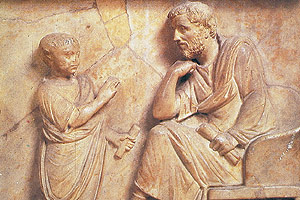Rome imposed its political and administrative structures upon the countries which it incorporated into the empire, but this did not stop it easily assimilating foreign cultural riches.
The Romans greatly admired the cities of Greece and the East, and adapted the arch, the vault and the cupola from the later. This gave Roman architecture its characteristic grandeur. In their temples they copied some Greek elements, although the Roman Pantheon turned out to be an artistic revolution because of its circular base and the fact that it had a cupola, whereas the Greek temples were rectangular.
Some Roman architectural works which stood out were the arches of triumph, commemorative columns and the basilicas.
Important public works were the roads, (straight roads such as the Via Appia), bridges, aqueducts, public baths and hot springs.
Roman sculpture is distinguished by its inclination towards portraits and realism, which explains why the most well known Roman works of art are their busts and their equestrian statues. Furthermore, the Romans specialised in carving beautiful historical relieves onto their arches of triumph and columns.
The decoration of houses and some other buildings (such as baths) with beautiful and magnificent frescos and mosaics became widespread. The best conserved paintings are the murals of Pompeii which show different styles used successively from the 2nd Century B.C. until the destruction of the city in 79 A.D.
Religion
Original Roman religion worshipped supernatural forces called numina, such as Faunus and Flora.
It is worth noting that the transcendence of religion in Rome was not the same as in other civilizations such as ancient Greece. Therefore, when these two peoples came into contact, the Romans assimilated the Greek gods into their theogony (the doctrine about the origin and genealogy of gods).
The cult of these divinities only affected the Romans at a superficial level. Therefore the most important Roman gods (along with their Greek homologues) were: Jupiter (Zeus), Mars (Ares), Phoebus (Apollo), Neptune (Poseidon) and Bacchus (Dionysus). The goddesses were Juno (Hera), Diana (Aphrodite), and Minerva (Athena). Prominent among the gods were Jupiter, Juno and Minerva, who formed the «Capitoline Triad» (so named for having its temple in the Capitolium.)
However, contact with the East from the 1st Century A.D onwards gave place to a real invasion of Eastern religions such as the religion of Isis (of Egyptian origin) or of Mithra (of Persian origin). Finally in the Low Empire, Christianity, following Theodosius’ recognition, eventually overcame other religions.
Roman Law
The importance of Roman laws lies in its providing, to a great extent, the foundations for the canonical law of the Catholic Church and the majority of the legal systems of modern nations.
The first body of laws was the code named «The Law of the Twelve Tablets» (451 B.C.), written down as a consequence of the pressures the plebs applied to achieve political equality.
Other decrees coming from the emperor, the praetors, and Senate were added to this legal body.
The Roman jurists (specialists in law) distinguished between public law, private law and international law. The first regulated relations between the State and citizens; the second, relations among citizens, and the third, relations between different peoples.
Gaius, Papinianus, Ulpianus, Modestinus and Paulus were the most well known jurists.
Education
The fundamental objective of Roman education, carried out mainly in the bosom of the family, was to instil respect for traditional values.
Children of wealthy parents continued their education in schools at the age of six. Here, masters imparted an education based on the Greek model, giving students basic notions about reading, writing and mathematics.
When they reached the age of 11, a grammaticus (advanced teacher) taught them literature and the sciences (mathematics and astronomy). Having reached the age of 14, the youths who wanted to devote themselves to politics had to study oratory. Girls learnt to perform domestic tasks, while the poorest boys had to work.
In the last years of the empire, educational institutions which were true universities existed in the main cities (Rome, Athens and Byzantine). The teachers were designated by the State and they, as well as the students, enjoyed fiscal exemptions.








 Día Mundial del Libro y del Derecho de Autor
Día Mundial del Libro y del Derecho de Autor